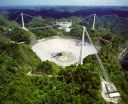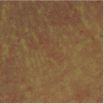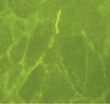(Press-News.org) The discovery of a split-second burst of radio waves by scientists using the Arecibo radio telescope in Puerto Rico provides important new evidence of mysterious pulses that appear to come from deep in outer space.
The finding by an international team of astronomers, published July 10 in The Astrophysical Journal, marks the first time that a so-called "fast radio burst" has been detected using an instrument other than the Parkes radio telescope in Australia. Scientists using the Parkes Observatory have recorded a handful of such events, but the lack of any similar findings by other facilities had led to speculation that the Australian instrument might have been picking up signals originating from sources on or near Earth.
"Our result is important because it eliminates any doubt that these radio bursts are truly of cosmic origin," said Victoria Kaspi, an astrophysics professor at McGill University in Montreal and Principal Investigator for the pulsar-survey project that detected this fast radio burst. "The radio waves show every sign of having come from far outside our galaxy – a really exciting prospect."
Exactly what may be causing such radio bursts represents a major new enigma for astrophysicists. Possibilities include a range of exotic astrophysical objects, such as evaporating black holes, mergers of neutron stars, or flares from magnetars -- a type of neutron star with extremely powerful magnetic fields.
"Another possibility is that they are bursts much brighter than the giant pulses seen from some pulsars," notes James Cordes, a professor of astronomy at Cornell University and co-author of the new study.
The unusual pulse was detected on Nov. 2, 2012, at the Arecibo Observatory, a National Science Foundation-sponsored facility that boasts the world's largest and most sensitive radio telescope, with a radio-mirror dish spanning 305 metres and covering about 20 acres.
While fast radio bursts last just a few thousandths of a second and have rarely been detected, the international team of scientists reporting the Arecibo finding confirm previous estimates that these strange cosmic bursts occur roughly 10,000 times a day over the whole sky. This astonishingly large number is inferred by calculating how much sky was observed, and for how long, in order to make the few detections that have so far been reported.
"The brightness and duration of this event, and the inferred rate at which these bursts occur, are all consistent with the properties of the bursts previously detected by the Parkes telescope in Australia," said Laura Spitler, lead author of the new paper. Dr. Spitler, now a postdoctoral researcher at the Max Planck Institute for Radio Astronomy in Bonn, Germany, was a PhD student at Cornell when the research work began.
The bursts appear to be coming from beyond the Milky Way galaxy based on measurement of an effect known as plasma dispersion. Pulses that travel through the cosmos are distinguished from man-made interference by the effect of interstellar electrons, which cause radio waves to travel more slowly at lower radio frequencies. The burst detected by the Arecibo telescope has three times the maximum dispersion measure that would be expected from a source within the galaxy, the scientists report.
The discovery was made as part of the Pulsar Arecibo L-Band Feed Array (PALFA) survey, which aims to find a large sample of pulsars and to discover rare objects useful for probing fundamental aspects of neutron star physics and testing theories of gravitational physics.
Efforts are now under way to detect radio bursts using radio telescopes that can observe broad swaths of the sky to help identify them. Telescopes under construction in Australia and South Africa as well as the CHIME telescope in Canada have the potential to detect fast radio bursts; astronomers say these and other new facilities could pave the way for many more discoveries and a better understanding of this mysterious cosmic phenomenon.
INFORMATION:
The research was supported by grants from the European Research Council, the National Science Foundation, the Natural Sciences and Engineering Research Council of Canada, the Fonds de recherche du Québec - Nature et technologies, and the Canadian Institute for Advanced Research, among others. Prof. Kaspi is the R. Howard Webster Foundation Fellow of CIFAR's Cosmology & Gravity program; she also holds the Lorne Trottier Chair in Astrophysics and Cosmology as well as a Canada Research Chair at McGill.
The Arecibo Observatory is operated by SRI International in alliance with Ana G. Méndez-Universidad Metropolitana and the Universities Space Research Association, under a cooperative agreement with the National Science Foundation (AST-1100968). The data were processed on the ATLAS cluster of the Max Planck Institute for Gravitational Physics (Albert Einstein Institute), Hannover, Germany.
"Fast Radio Burst Discovered in the Arecibo Pulsar ALFA Survey," by L.G. Spitler, J.M. Cordes, et al. The Astrophysical Journal. Published online July 10, 2014.
Radio-burst discovery deepens astrophysics mystery
Brief pulse detected by Arecibo telescope appears to come from far beyond our galaxy
2014-07-10
ELSE PRESS RELEASES FROM THIS DATE:
Working to loosen the grip of severe mental illness
2014-07-10
A neuroscientist at Rutgers University-Newark says the human brain operates much the same whether active or at rest – a finding that could provide a better understanding of schizophrenia, bipolar disorder and other serious mental health conditions that afflict an estimated 13.6 million Americans.
In newly published research in the journal Neuron, Michael Cole, an assistant professor at the Center for Molecular and Behavioral Neuroscience, determined that the underlying brain architecture of a person at rest is basically the same as that of a person performing a variety ...
How antioxidants can accelerate cancers, and why they don't protect against them
2014-07-10
Cold Spring Harbor, NY – For decades, health-conscious people around the globe have taken antioxidant supplements and eaten foods rich in antioxidants, figuring this was one of the paths to good health and a long life.
Yet clinical trials of antioxidant supplements have repeatedly dashed the hopes of consumers who take them hoping to reduce their cancer risk. Virtually all such trials have failed to show any protective effect against cancer. In fact, in several trials antioxidant supplementation has been linked with increased rates of certain cancers. In one trial, ...
Depressed men with prostate cancer are diagnosed later stage, get less effective therapies
2014-07-10
Depressed men with localized prostate cancer were more likely to be diagnosed with more aggressive prostate cancer, received less effective treatments and survived for shorter times than prostate cancer patients who were not depressed, a UCLA study has found.
The negative outcomes may be the result of several factors such as bias against the mentally ill, depression's impact on biological cancer processes, the depressed man's lack of investment in his general health and disinterest in receiving more effective care, and missed opportunities by physicians to educate patients ...
Scientist finds link between antibiotics, bacterial biofilms and chronic infections
2014-07-10
Researchers from the University of Southern California and the Oak Crest Institute of Science have discovered the link between antibiotics and bacterial biofilm formation leading to chronic lung, sinus and ear infections. The study results, published in the current issue of PLOS ONE, illustrate how bacterial biofilms can actually thrive, rather than decrease, when given low doses of antibiotics.
"This research addresses the long standing issues surrounding chronic ear infections and why some children experience repeated ear infections even after antibiotic treatment," ...
BMSCs with Nogo-66 receptor gene silencing for repair of spinal cord injury
2014-07-10
After central nervous system injury, the increase in Nogo protein is mediated by Nogo-66 receptor gene, leading to the collapse of growth cones and inhibiting the extension of neuronal neurites. Zhiyuan Li and his team, Heibei Xingtai People's Hospital, China used RNA interference to silence Nogo-66 receptor gene expression in bone marrow mesenchymal stem cells (BMSCs), blocked the inhibitory effect of Nogo protein, promoted the process growth of neurons differentiated by transplanted cells, improved the therapeutic effects and increased the success rate of BMSCs transplantation ...
Inhibition of NgR expression reduces apoptotic retinal ganglion cells in diabetes
2014-07-10
Activation of Nogo receptor (NgR) is an essential factor of nerve regeneration inhibition, neuronal atrophy and even apoptosis. Upregulation of NgR expression is an important cause of cell apoptosis and visual extinction in some diseases including glaucoma. Whether ganglion cell apoptosis is related to NgR gene expression in diabetes mellitus remains poorly understood. Dr. Xuezheng Liu and his team, Liaoning Medical University, China interfered NgR expression in the retinal ganglion cells of rats with diabetes mellitus and found that Rho kinase expression was obviously ...
Fusion protein of single-chain variable domain fragments and myasthenia gravis
2014-07-10
Single-chain variable domain fragment (scFv) 637 is an antigen-specific scFv of myasthenia gravis and it can bind to acetylcholine receptor in the residues 67-76 of α-subunit of acetylcholine receptor. Dr. Fanping Meng and his team, College of Medicine, Yanbian University in China conjugated scFv and human serum albumin genes and detected the fusion protein in Pichia pastoris. Results showed that the fusion protein bound to acetylcholine receptors in neuromuscular junction of human intercostal muscle and the inhibition rate of fusion protein binding to acetycholine ...
How does miR-21 promote the differentiation of hair follicle-derived NCSCs into SCs?
2014-07-10
Hair follicle-derived neural crest stem cells (NCSCs) can be induced to differentiate into Schwann cells (SCs). However, the underlying regulatory mechanism during cell differentiation remains poorly understood. Dr. Yuxin Ni and her team, Hospital of Stomatology, Jilin University, China isolated NCSCs from human hair follicle and induced them to differentiate into SCs. MicroRNA (miR-21) expression was gradually increased during the differentiation of NCSCs into SCs. After transfection with the miR-21 agonist (agomir-21), the differentiation capacity of NCSCs was increased. ...
The optimal mitomycin C concentration for intact peripheral nerve structure and function
2014-07-10
Recently, local scar adhesion after laminectomy always challenges the worldwide scholars engaged in spine surgery. Mitomycin C, a classical anti-tumor drug, has been attempted to be used to effectively inhibit scar adhesion after laminectomy and some encouraging outcomes have been achieved. However, there is evidence that mitomycin C has inherent toxicity and other side effects when it is locally used. Whether mitomycin C can influence peripheral nerve structure and function remains unclear. Dr. Tao Sui and his team, the First Affiliated Hospital of Nanjing Medical University, ...
New research: Fresh avocado enhances absorption of essential nutrients for healthy living
2014-07-10
IRVINE, Calif. (July 10, 2014) – Consuming a whole fresh avocado with either an orange-colored tomato sauce or raw carrots significantly enhanced provitamin A carotenoid (alpha- and beta-carotene) absorption and conversion of these carotenoids to an active form of vitamin A, according to new research (1) published in The Journal of Nutrition.
Vitamin A is involved in reproductive health and growth promotion; helps support healthy skin, immune function, and vision; and has antioxidant properties. Provitamin A carotenoids, like alpha- and beta-carotene, impart the orange ...
LAST 30 PRESS RELEASES:
First Editorial of 2026: Resisting AI slop
Joint ground- and space-based observations reveal Saturn-mass rogue planet
Inheritable genetic variant offers protection against blood cancer risk and progression
Pigs settled Pacific islands alongside early human voyagers
A Coral reef’s daily pulse reshapes microbes in surrounding waters
EAST Tokamak experiments exceed plasma density limit, offering new approach to fusion ignition
Groundbreaking discovery reveals Africa’s oldest cremation pyre and complex ritual practices
First breathing ‘lung-on-chip’ developed using genetically identical cells
How people moved pigs across the Pacific
Interaction of climate change and human activity and its impact on plant diversity in Qinghai-Tibet plateau
From addressing uncertainty to national strategy: an interpretation of Professor Lim Siong Guan’s views
Clinical trials on AI language model use in digestive healthcare
Scientists improve robotic visual–inertial trajectory localization accuracy using cross-modal interaction and selection techniques
Correlation between cancer cachexia and immune-related adverse events in HCC
Human adipose tissue: a new source for functional organoids
Metro lines double as freight highways during off-peak hours, Beijing study shows
Biomedical functions and applications of nanomaterials in tumor diagnosis and treatment: perspectives from ophthalmic oncology
3D imaging unveils how passivation improves perovskite solar cell performance
Enriching framework Al sites in 8-membered rings of Cu-SSZ-39 zeolite to enhance low-temperature ammonia selective catalytic reduction performance
AI-powered RNA drug development: a new frontier in therapeutics
Decoupling the HOR enhancement on PtRu: Dynamically matching interfacial water to reaction coordinates
Sulfur isn’t poisonous when it synergistically acts with phosphine in olefins hydroformylation
URI researchers uncover molecular mechanisms behind speciation in corals
Chitin based carbon aerogel offers a cleaner way to store thermal energy
Tracing hidden sources of nitrate pollution in rapidly changing rural urban landscapes
Viruses on plastic pollution may quietly accelerate the spread of antibiotic resistance
Three UH Rainbow Babies & Children’s faculty elected to prestigious American Pediatric Society
Tunnel resilience models unveiled to aid post-earthquake recovery
Satellite communication systems: the future of 5G/6G connectivity
Space computing power networks: a new frontier for satellite technologies
[Press-News.org] Radio-burst discovery deepens astrophysics mysteryBrief pulse detected by Arecibo telescope appears to come from far beyond our galaxy









